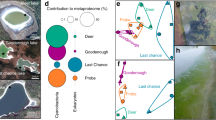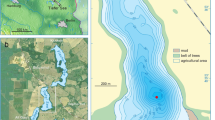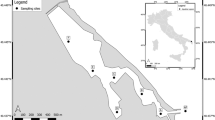Abstract
Human impacts on biodiversity are well recognized, but uncertainties remain regarding patterns of diversity change at different spatial and temporal scales. Changes in microbial assemblages are, in particular, not well understood, partly due to the lack of community composition data over relevant scales of space and time. Here, we investigate biodiversity patterns in cyanobacterial assemblages over one century of eutrophication and climate change by sequencing DNA preserved in the sediments of ten European peri-Alpine lakes. We found species losses and gains at the lake scale, while species richness increased at the regional scale over approximately the past 100 years. Our data show a clear signal for beta diversity loss, with the composition and phylogenetic structure of assemblages becoming more similar across sites in the most recent decades, as have the general environmental conditions in and around the lakes. We attribute patterns of change in community composition to raised temperatures affecting the strength of the thermal stratification and, as a consequence, nutrient fluctuations, which favoured cyanobacterial taxa able to regulate buoyancy. Our results reinforce previous reports of human-induced homogenization of natural communities and reveal how potentially toxic and bloom-forming cyanobacteria have widened their geographic distribution in the European temperate region.
This is a preview of subscription content, access via your institution
Access options
Access Nature and 54 other Nature Portfolio journals
Get Nature+, our best-value online-access subscription
$29.99 / 30 days
cancel any time
Subscribe to this journal
Receive 12 digital issues and online access to articles
$119.00 per year
only $9.92 per issue
Buy this article
- Purchase on Springer Link
- Instant access to full article PDF
Prices may be subject to local taxes which are calculated during checkout





Similar content being viewed by others
References
Vitousek, P. M., Mooney, H. A., Lubchenco, J. & Melillo, J. M. Human domination of Earth’s ecosystems. Science 277, 494–499 (1997).
Newbold, T. et al. Global effects of land use on local terrestrial biodiversity. Nature 520, 45–50 (2015).
Vellend, M. Conceptual synthesis in community ecology. Q. Rev. Biol. 85, 183–206 (2010).
McGill, B. J., Dornelas, M., Gotelli, N. J. & Magurran, A. E. Fifteen forms of biodiversity trend in the anthropocene. Trends Ecol. Evol. 30, 104–113 (2015).
González-Orozco, C. E. et al. Phylogenetic approaches reveal biodiversity threats under climate change. Nat. Clim. Change 6, 1110–1114 (2016).
Vellend, M. et al. Estimates of local biodiversity change over time stand up to scrutiny. Ecology 98, 583–590 (2017).
Dornelas, M. et al. Assemblage time series reveal biodiversity change but not systematic loss. Science 344, 296–299 (2014).
Magurran, A. E., Dornelas, M., Moyes, F., Gotelli, N. J. & McGill, B. Rapid biotic homogenization of marine fish assemblages. Nat. Commun. 6, 8405 (2015).
Gámez-Virués, S. et al. Landscape simplification filters species traits and drives biotic homogenization. Nat. Commun. 6, 8568 (2015).
Cardinale, B. J. et al. Corrigendum: biodiversity loss and its impact on humanity. Nature 486, 59–67 (2012).
Adrian, R., O’Reilly, C. M., Zagarese, H., Baines, S. B. & Dag, O. Lakes as sentinels of climate change. Limnol. Oceanogr. 54, 2283–2297 (2009).
Sukenik, A., Quesada, A. & Salmaso, N. Global expansion of toxic and non-toxic cyanobacteria: effect on ecosystem functioning. Biodivers. Conserv. 24, 889–908 (2015).
Paerl, H. W. & Huisman, J. Blooms like it hot. Science 320, 57–58 (2008).
Carey, C. C., Ibelings, B. W., Hoffmann, E. P., Hamilton, D. P. & Brookes, J. D. Eco-physiological adaptations that favour freshwater cyanobacteria in a changing climate. Water Res. 46, 1394–1407 (2012).
Rigosi, A., Carey, C. C., Ibelings, B. W. & Brookes, J. D. The interaction between climate warming and eutrophication to promote cyanobacteria is dependent on trophic state and varies among taxa. Limnol. Ocean. 59, 99–114 (2014).
Vonlanthen, P. et al. Eutrophication causes speciation reversal in whitefish adaptive radiations. Nature 482, 357–362 (2012).
Downing, J. A. J., Watson, S. S. B. & McCauley, E. Predicting cyanobacteria dominance in lakes. Can. J. Fish. Aquat. Sci. 58, 1905–1908 (2001).
Taranu, Z. E. et al. Acceleration of cyanobacterial dominance in north temperate–subarctic lakes during the Anthropocene. Ecol. Lett. 18, 375–384 (2015).
Sinha, R. et al. Increased incidence of Cylindrospermopsis raciborskii in temperate zones—is climate change responsible? Water Res. 46, 1408–1419 (2012).
Salmaso, N. et al. Historical colonization patterns of Dolichospermum lemmermannii (cyanobacteria) in a deep lake south of the Alps. Adv. Oceanogr. Limnol. 6, 1–4 (2015).
Salmaso, N., Capelli, C., Shams, S. & Cerasino, L. Expansion of bloom-forming Dolichospermum lemmermannii (Nostocales, Cyanobacteria) to the deep lakes south of the Alps: colonization patterns, driving forces and implications for water use. Harmful Algae 50, 76–87 (2015).
Ernst, B., Hoeger, S. J., O’Brien, E. & Dietrich, D. R. Abundance and toxicity of Planktothrix rubescens in the pre-alpine Lake Ammersee, Germany. Harmful Algae 8, 329–342 (2009).
Otten, T. G., Xu, H., Qin, B., Zhu, G. & Paerl, H. W. Spatiotemporal patterns and ecophysiology of toxigenic microcystis blooms in Lake Taihu, China: implications for water quality management. Environ. Sci. Technol. 46, 3480–3488 (2012).
Glibert, P. M., Harrison, J., Heil, C. & Seitzinger, S. Escalating worldwide use of urea—a global change contributing to coastal eutrophication. Biogeochemistry 77, 441–463 (2006).
Domaizon, I., Winegardner, A., Capo, E., Gauthier, J. & Gregory-Eaves, I. DNA-based methods in paleolimnology: new opportunities for investigating long-term dynamics of lacustrine biodiversity. J. Paleolimnol. 58, 1–21 (2017).
Domaizon, I. et al. DNA from lake sediments reveals the long-term dynamics and diversity of Synechococcus assemblages. Biogeosci. Discuss. 10, 2515–2564 (2013).
Savichtcheva, O. et al. Effects of nutrients and warming on Planktothrix dynamics and diversity: a palaeolimnological view based on sedimentary DNA and RNA. Freshw. Biol. 60, 31–49 (2015).
Monchamp, M.-E., Walser, J.-C., Pomati, F. & Spaak, P. Sedimentary DNA reveals cyanobacterial community diversity over 200 years in two perialpine lakes. Appl. Environ. Microbiol. 82, 6472–6482 (2016).
Vellend, M. et al. Global meta-analysis reveals no net change in local-scale plant biodiversity over time. Proc. Natl Acad. Sci. USA 110, 19456–19459 (2013).
Hou, W. et al. Identification of photosynthetic plankton communities using sedimentary ancient DNA and their response to late-Holocene climate change on the Tibetan Plateau. Sci. Rep. 4, 6648 (2014).
Coolen, M. J. L. et al. Ancient DNA derived from alkenone-biosynthesizing haptophytes and other algae in Holocene sediments from the Black Sea. Paleoceanography 21, 1–17 (2006).
Boere, A. C., Sinninghe Damsté, J. S., Rijpstra, W. I. C., Volkman, J. K. & Coolen, M. J. L. Source-specific variability in post-depositional DNA preservation with potential implications for DNA based paleoecological records. Org. Geochem. 42, 1216–1225 (2011).
Züllig, H. Untersuchungen über die stratigraphie von carotinoiden im geschichteten sediment von 10 Schweizer seen zur erkundung früherer phytoplankton-entfaltungen. Schweiz. Z. Hydrol. 44, 1–98 (1982).
Liechti, P. L’Etat des Lacs en Suisse (Office Fédéral de l'Environnement, des Forêts et du Paysage, 1994).
Pomati, F., Matthews, B., Jokela, J., Schildknecht, A. & Ibelings, B. W. Effects of re-oligotrophication and climate warming on plankton richness and community stability in a deep mesotrophic lake. Oikos 121, 1317–1327 (2012).
Posch, T., Köster, O., Salcher, M. M. & Pernthaler, J. Harmful filamentous cyanobacteria favoured by reduced water turnover with lake warming. Nat. Clim. Change 2, 809–813 (2012).
Livingstone, D. M. Thermal structure of a large temperate central European lake. Clim. Change 57, 205–225 (2003).
Matthews, B. & Pomati, F. Reversal in the relationship between species richness and turnover in a phytoplankton community. Ecology 93, 2435–2447 (2012).
Sukenik, A. et al. Invasion of Nostocales (Cyanobacteria) to subtropical and temperate freshwater lakes—physiological, regional, and global driving forces. Front. Microbiol. 3, 1–9 (2012).
Cirés, S., Wörmer, L., Wiedner, C. & Quesada, A. Temperature-dependent dispersal strategies of Aphanizomenon ovalisporum (Nostocales, Cyanobacteria): implications for the annual life cycle. Microb. Ecol. 65, 12–21 (2013).
Gallina, N., Salmaso, N., Morabito, G. & Beniston, M. Phytoplankton configuration in six deep lakes in the peri-Alpine region: are the key drivers related to eutrophication and climate? Aquat. Ecol. 47, 177–193 (2013).
Salmaso, N. Long-term phytoplankton community changes in a deep subalpine lake: responses to nutrient availability and climatic fluctuations. Freshw. Biol. 55, 825–846 (2010).
Anneville, O., Souissi, S., Gammeter, S. & Straile, D. Seasonal and inter-annual scales of variability in phytoplankton assemblages: comparison of phytoplankton dynamics in three peri-Alpine lakes over a period of 28 years. Freshw. Biol. 49, 98–115 (2004).
Reynolds, C., Oliver, R. & Walsby, A. Cyanobacterial dominance: the role of buoyancy regulation in dynamic lake environments. NZ J. Mar. Freshw. Res. 21, 379–390 (1987).
Beard, S. J., Handley, B. A., Hayes, P. K. & Walsby, A. E. The diversity of gas vesicle genes in Planktothrix rubescens from Lake Zurich. Microbiology 145, 2757–2768 (1999).
Jacquet, S. et al. The proliferation of the toxic cyanobacterium Planktothrix rubescens following restoration of the largest natural French lake (Lac du Bourget). Harmful Algae 4, 651–672 (2005).
Walsby, A. E. Stratification by cyanobacteria in lakes: a dynamic buoyancy model indicates size limitations met by Planktothrix rubescens filaments. New Phytol. 168, 365–376 (2005).
Litchman, E. & Klausmeier, C. A. Trait-based community ecology of phytoplankton. Annu. Rev. Ecol. Evol. Syst. 39, 615–639 (2008).
Birtel, J. & Matthews, B. Grazers structure the bacterial and algal diversity of aquatic metacommunities. Ecology 97, 3472–3484 (2016).
Gossner, M. M. et al. Land-use intensification causes multitrophic homogenization of grassland communities. Nature 540, 266–269 (2016).
Begert, M., Schlegel, T. & Kirchhofer, W. Homogeneous temperature and precipitation series of Switzerland from 1864 to 2000. Int. J. Climatol. 25, 65–80 (2005).
Schmidt, W. Über die temperatur- und stabilitätsverhältnisse von seen. Geogr. Ann. 10, 145–177 (1928).
Schwefel, R., Gaudard. A., Wüest, A. & Bouffard, D. Effects of climate change on deepwater oxygen and winter mixing in a deep lake (Lake Geneva): comparing observational findings and modeling. Water Resour. Res. 52, 8811–8826 (2016).
Nübel, U., Garcia-pichel, F., Muyzer, G., Nu, U. & Muyzer, G. PCR primers to amplify 16S rRNA genes from cyanobacteria. Appl. Environ. Microbiol. 63, 3327–3332 (1997).
Edgar, R. C. UPARSE: highly accurate OTU sequences from microbial amplicon reads. Nat. Methods 10, 996–998 (2013).
McDonald, D. et al. An improved Greengenes taxonomy with explicit ranks for ecological and evolutionary analyses of bacteria and archaea. ISME J. 6, 610–618 (2012).
Caporaso, J. G. et al. PyNAST: a flexible tool for aligning sequences to a template alignment. Bioinformatics 26, 266–267 (2010).
Price, M. N., Dehal, P. S. & Arkin, A. P. FastTree 2—approximately maximum-likelihood trees for large alignments. PLoS ONE 5, e9490 (2010).
R Core Team R: A Language and Environment for Statistical Computing (R Foundation for Statistical Computing, Vienna, 2013).
McMurdie, P. J. & Holmes, S. phyloseq: an R package for reproducible interactive analysis and graphics of microbiome census data. PLoS ONE 8, e61217 (2013).
Faith, D. P., Minchin, P. R. & Belbin, L. Compsitional dissimilarity as a robust measure of ecogical distance. Vegetatio 69, 57–68 (1987).
Lozupone, C. & Knight, R. UniFrac: a new phylogenetic method for comparing microbial communities. Appl. Environ. Microbiol. 71, 8228–8235 (2005).
Oksanen, J. et al. vegan: Community Ecology Package. R Package Version 2.0-10. (R Foundation for Statistical Computing, Vienna, 2013); http://CRAN.R-project.org/package=vegan.
Weinstein, J. N. et al. An information-intensive approach to the molecular pharmacology of cancer. Science 275, 343–349 (1997).
Acknowledgements
The high-throughput sequencing data were produced at Fasteris (Geneva). We thank J.-C. Walser (Genetic Diversity Centre, ETH Zürich) for bioinformatics support and B. Müller for helping with the lake chemical data acquisition. We thank M. Thali, A. Lück, A. Zwyssig, C. Chardon, A. Lami, S. Gerli, H. Penson and C. Ouellet-Plamondon for technical assistance, as well as M. Lavrieux for help with the sediment dating. We are grateful to I. Gregory-Eaves, H. Hartikainen, R. Ptacnik, K. Räsänen, C. Tellenbach and M. K. Thomas for intellectual feedback and fruitful discussions. Coring, dating and DNA extractions for lakes Annecy and Geneva were performed in the context of the 'REPLAY' programme funded by the Structural Ecosphere Continent and Coastal Initiative at the Institut National des Sciences de l'Univers and the Iper Retro programme funded by the Agence Nationale de la Recherche VULNS-005 (France). The physical and chemical data were produced by Amt für Abfall, Wasser, Energie und Luft (Canton Zurich) for Greifensee, Wasserversorgung Zürich for Lake Zurich, Lake Constance Water Supply for Lake Constance, Abteilung für Umwelt Kanton Aargau (A. Stöckli) for Hallwilersee, Eawag/Kanton Luzern for Baldeggersee, the Swiss Federal Office for the Environment and F. Lepori at the Istituto Scienze della Terra, ITS SUPSI, Lugano for Lake Lugano, M. Manca (Consiglio Nazionale delle Ricerche, Institute of Ecosystem Study, Italy) for Lake Maggiore, the Observatory of the Alpine Lakes, Commission Internationale pour la Protection des Eaux du Léman (CIPEL), Syndicat Mixte du Lac d'Annecy (SILA) and Système d'Information de l'Observatoire des Lacs Alpins (OLA-IS) developed by Eco-Informatics, Observatoire Recherche en Environnement (ORE INRA) for the lakes Annecy and Geneva and G. Tartari (Istituto di Ricerca sulle Acque, Consiglio Nazionale delle Ricerche, Brugherio, Italy) for Lake Pusiano. This work was supported by the Swiss Enlargement Contribution, project IZERZ0 – 142165, 'CyanoArchive' to P.S., in the framework of the Romanian–Swiss Research Programme.
Author information
Authors and Affiliations
Contributions
M.-E.M., P.S. and F.P. designed the study. I.D. and N.D. contributed the materials and analysis tools and samples. M.-E.M. and I.D. collected the data. All analyses were carried out by M.-E.M. and D.B. M.-E.M. and F.P. wrote the manuscript, which was revised and edited by all authors.
Corresponding authors
Ethics declarations
Competing interests
The authors declare no competing financial interests.
Additional information
Publisher’s note: Springer Nature remains neutral with regard to jurisdictional claims in published maps and institutional affiliations.
Supplementary information
Supplementary Information
Supplementary Figures 1–4
Supplementary Table 1
Overview of lake characteristics. List of lakes geographical location, main morphological characteristics, and current trophic status
Supplementary Table 2
Overview of lake chemical data used in this study. The table includes the source of phosphorus and nitrogen data, and the duration of the nutrient time series used in this study
Supplementary Table 3
List of all samples used in this study. The table includes the sample ID, the PCR primer sequences and the tag sequences used in the sequencing library preparation
Rights and permissions
About this article
Cite this article
Monchamp, ME., Spaak, P., Domaizon, I. et al. Homogenization of lake cyanobacterial communities over a century of climate change and eutrophication. Nat Ecol Evol 2, 317–324 (2018). https://doi.org/10.1038/s41559-017-0407-0
Received:
Accepted:
Published:
Issue Date:
DOI: https://doi.org/10.1038/s41559-017-0407-0
This article is cited by
-
Water quality and habitat drive phytoplankton taxonomic and functional group patterns in the Yangtze River
Ecological Processes (2024)
-
Impacts of ammoniacal odour removal bioagent on air bacterial community
Advanced Biotechnology (2024)
-
Spatial distribution of sedimentary DNA is taxon-specific and linked to local occurrence at intra-lake scale
Communications Earth & Environment (2023)
-
Metagenomic mapping of cyanobacteria and potential cyanotoxin producing taxa in large rivers of the United States
Scientific Reports (2023)
-
Disruption of ecological networks in lakes by climate change and nutrient fluctuations
Nature Climate Change (2023)



